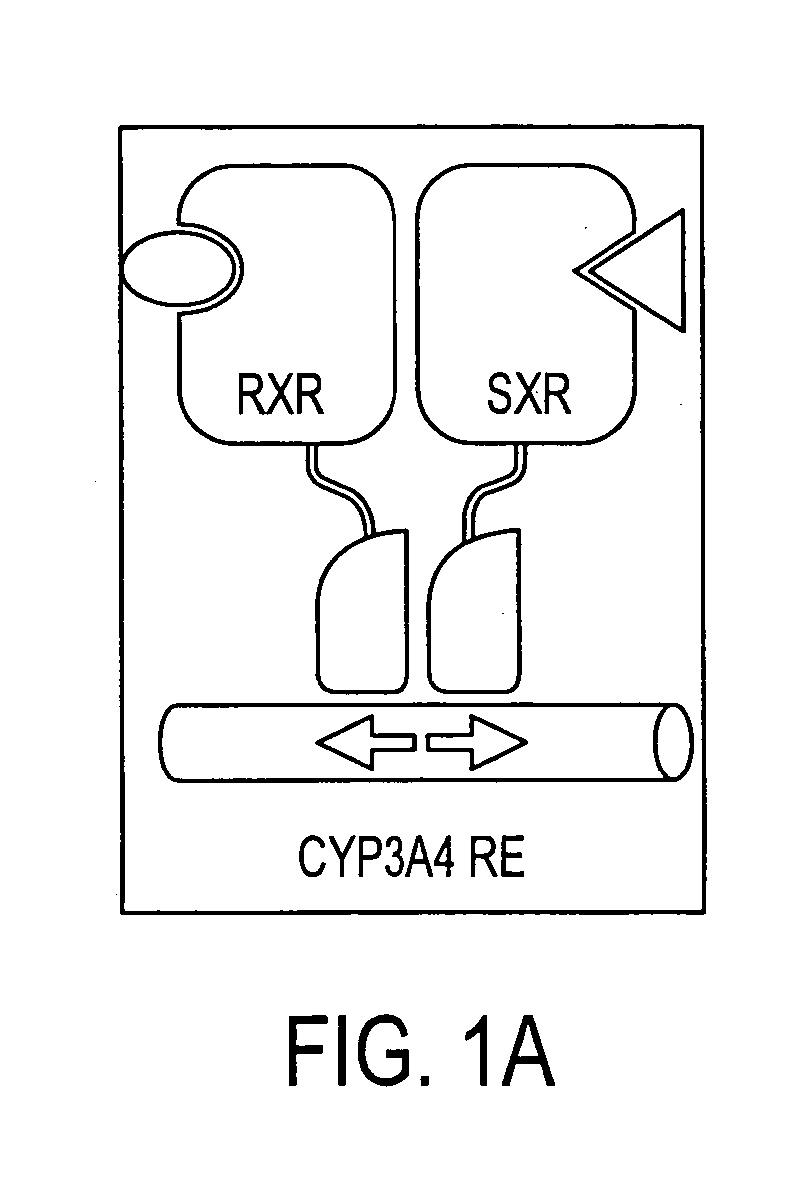Methods of modulating drug clearance mechanisms by altering SXR activity
- Summary
- Abstract
- Description
- Claims
- Application Information
AI Technical Summary
Benefits of technology
Problems solved by technology
Method used
Image
Examples
example 1
Paclitaxel Activates SXR
[0075] To explore whether paclitaxel can activate SXR, CV-1 cells were transiently transfected with vectors expressing Gal4 fused to the ligand binding domain of human SXR (Gal-L-SXR) or to the human RXRα ligand binding domain (Gal-L-RXR). After transfection, cells were treated with the following compounds: 10 μM rifampicin, 10 μM SR12813, 10 μM pregnenolone-16α-carbonitrile (Preg-16-CN), 10 μM paclitaxel, 100 nM LG268, 10 μM 6α-hydroxypaclitaxel and 10 μM 3′p-hydroxypaclitaxel. The Gal4 reporter activity was normalized to the internal β-galactosidase control and the data plotted as fold activation relative to untreated cells. All transfections contained the Gal4 reporter and a β-galactosidase expression vector as an internal control.
[0076] CV-1 cells were grown in Dulbecco's Modified Eagle's medium supplemented with 10% resin-charcoal stripped fetal bovine serum, 50 U / ml penicillin G and 50 μg / ml streptomycin sulfate (DMEM-FBS) at 37° C. in 5% CO2. One day...
example 2
SXR Induces CYP2C8 and MDR1 Expression
[0079] To compare paclitaxel's ability to activate CYP3A4 expression with that of other SXR agonists, primary human hepatocytes which natively express SXR, prepared according to known methods, were treated with SXR agonists and CYP3A4 expression was monitored by northern analysis. Northern analysis was performed as follows. Primary human hepatocytes were obtained from Clonetics (Walkersville, Md.) and maintained in Hepatocyte Maintenance Medium supplemented with dexamethasone and insulin according to the vendors instructions. Cells were treated with the indicated SXR agonists for 48 hours and total RNA was isolated using the Trizol reagent.
[0080] Human LS180 cells were maintained in Eagle's minimal essential medium supplemented with 10% fetal bovine serum, 1 mM sodium pyruvate, 2 mM L-glutamine, non-essential amino acids, 50 U / ml penicillin G and 50 μg / ml streptomycin sulfate. One day prior to treatment, the LS180 cells were switched to phenol...
example 3
Activation of MDR1 by a Constitutively Active SXR
[0083] To further confirm the link between SXR and MDR1, a constitutively active variant of SXR was assayed for MDR1 activation in the absence of SXR ligands. CV-1 cells were transiently transfected as described in Example 1 with an SXR reporter (CYP3A4x3-TK-luc) and expression vectors for native human SXR or human SXR fused to the Herpes VP16 transactivation domain (VP-SXR), a constitutively active version of SXR. After transfection, cells were maintained in media without an SXR agonist. Reporter activity was determined and normalized to the internal β-galactosidase control. As expected, wild-type SXR was inactive in the absence of ligand, however the VP-SXR chimera constitutively activated a reporter construct containing SXR response elements from the CYP3A4 promoter. See FIG. 5.
[0084] human LS180 cells were transiently transfected with a green fluorescent protein (GFP) expression vector alone (−) or with GFP and VP-SXR and mainta...
PUM
| Property | Measurement | Unit |
|---|---|---|
| Time | aaaaa | aaaaa |
| Time | aaaaa | aaaaa |
| Time | aaaaa | aaaaa |
Abstract
Description
Claims
Application Information
 Login to View More
Login to View More - R&D
- Intellectual Property
- Life Sciences
- Materials
- Tech Scout
- Unparalleled Data Quality
- Higher Quality Content
- 60% Fewer Hallucinations
Browse by: Latest US Patents, China's latest patents, Technical Efficacy Thesaurus, Application Domain, Technology Topic, Popular Technical Reports.
© 2025 PatSnap. All rights reserved.Legal|Privacy policy|Modern Slavery Act Transparency Statement|Sitemap|About US| Contact US: help@patsnap.com



